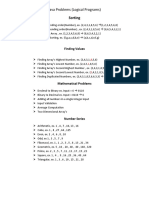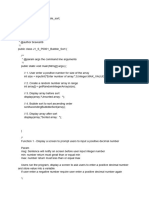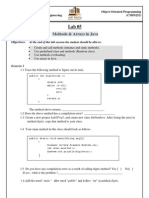Question 1 a.
Search for a name Write a program to accept an array of names and a name and check whether the name is present in the array. Return the count of occurrence. Use the following array as input {Dave, Ann, George, Sam, Ted, Gag, Saj, Agati, Mary, Sam, Ayan, Dev, Kity, Meery, Smith, Johnson, Bill, Williams, Jones, Brown, Davis, Miller, Wilson, Moore, Taylor, Anderson, Thomas, Jackson} Program : import java.io.*; import java.util.Scanner; class program1 { public static void main(String args[]) { String[] names={Dave, Ann, George, Sam, Ted, Gag, Saj, Agati, Mary, Sam, Ayan, Dev, Kity, Meery, Smith, Johnson, Bill, Williams, Jones, Brown, Davis, Miller, Wilson, Moore, Taylor, Anderson, Thomas, Jackson}; Scanner sr= new Scanner(System.in); System.out.println("Enter a name to check"); String name=sr.nextLine(); int count=0; for(int i=0;i<names.length;i++) { if(names[i].equals(name)) count++; } if(count!=0) System.out.println("The Number of occurance of the Name is " + count ); else System.out.println("Word not Found"); } }
b. Improve the understandability of the below given code:
import java.util.*; class problem3 { int[] numArray = new int[10];
�public static void incrementElements (int[] integerArray) { int arraylen = integerArray.length; for (int i = 0; i < arraylen; i ++) { System.out.println(integerArray[i]); } for (int i = 0; i < arraylen; i ++) { integerArray[i] = integerArray[i] + 10; } for (int i=0; i < arraylen; i ++) { System.out.println(integerArray[i]); } }
Improve the understandability of the below given code: This code defines that when any element of the integer array is occurred then it is printed first and after that its incremented by 10 and then the resultant array is printed, the same code is being defined in the component classes of java.utill.* The component class is the abstract superclass of the non menu-related Abstract Window Toolkit components. Class component can also be extended directly to create a lightweight component. A lightweight component is a component that is not associated with a native opaque window. The code is predefined in the package and whenever we want to execute any application which wants the code. Then without writing the whole code we can directly import the package and execute that application. Step by step explanation: import java.util.*; //importing the required packages import java.io.*; class Problem3 //creating a class { public static void Increment(int[] arr) //defining the 'increment()'method with one integer parameter { int len = arr.length; // initializing a integer variable 'len' with the length, i.e. the no of elements in array System.out.println("\nBefore Increment, The Array was :"); for (int i = 0; i < len; i ++) //definition of 'for' loop toprint the current values of array { System.out.print(arr[i]+"\t"); } for (int i = 0; i < len; i ++) //definition of 'for' loop toincrement the current values of array {
�arr[i] = arr[i] + 10; //add 10 to each value of array } System.out.println("\n\nAfter Increment, The Array is :"); for (int i=0; i < len; i ++) //definition of 'for' loop to print the updated values of array { System.out.print(arr[i]+"\t"); } } //method definition ends public static void main(String args[]) //definition of 'main' methodstarts.. { int i,n; Console con=System.console(); //creating an object of console class System.out.print("\nEnter The Length of Array : "); n=Integer.parseInt(con.readLine()); //reading the value for no. of elements from console entered by user int[] a = new int[n];//initializing the array System.out.println("\nEnter Array values :");for(i=0;i<n;i++) //defining a 'for' loop to reading the values from console to be stored in array { a[i]=Integer.parseInt(con.readLine()); //reading user input from console } Increment(a); // calling the method 'increment()' with the 'array a' as its parameter } //main method ends }
Question 2 Greatest common divisor Calculate the greatest common divisor of two positive numbers a and b. gcd(a,b) is recursively defined as gcd(a,b) = a if a =b gcd(a,b) = gcd(a-b, b) if a >b gcd(a,b) = gcd(a, b-a) if b > a Program:
import java.io.*; import java.util.Scanner; class program2 { public static void main(String args[]) { Scanner sr= new Scanner(System.in); System.out.println("Enter The number a"); int a=sr.nextInt(); System.out.println("Enter The number b"); int b=sr.nextInt(); int gcd;
�if(a==b) gcd=a; else if(a>b) gcd=findgcd(a-b,b); else gcd=findgcd(b,b-a); System.out.println("The greatest common divisor of numbers " + a + " and " + b + " is " + gcd); } public static int findgcd(int c,int d) { if (d == 0) return c; return findgcd(d, c % d); } }
(b) Improve the understandability of the below given code: class Problem1 { int[] a; int nElems; public ArrayBub(int max) { a = new int[max]; } public void insert(int value) { a[nElems] = value; nElems++; } public void Sort() { int out, in; for(out=nElems-1; out>1; out--) for(in=0; in<out; in++) if( a[in] > a[in+1] ) swap(in, in+1); } public void swap(int one, int two) { long temp = a[one]; a[one] = a[two]; a[two] = temp; } }
�The above code explains bubble sorting implementation. Bubble sort is also known as exchange sort. Bubble sort is a simplest sorting algorithm. In bubble sort algorithm array is traversed from 0 to the length-1 index of the array and compared one element to the next element and swap values in between if the next element is Less than the previous element. In other words, bubble sorting algorithm compare two values and put the largest value at largest index. The algorithm follow the same steps repeatedly until the values of array is sorted. In worst-case the complexity of bubble sort is O(n2) and in best-case the complexity of bubble sort is O(n).
Say we have an array unsorted A[0],A[1],A[2]................ A[n-1] and A[n] as input. Then the following steps are followed by bubble sort algorithm to sort the values of an array. 1.Compare A[0] and A[1] . 2.If A[0]>A[1] then Swap A[0] and A[1]. 3.Take next A[1] and A[2]. 4.Comapre these values. 5.If A[1]>A[2] then swap A[1] and A[2] ............................................................................................................................... at last compare A[n-1] and A[n]. If A[n-1]>A[n] then swap A[n-1] and A[n]. As we see the highest value is reached at nth position. At next iteration leave nth value. Then apply the came steps repeatedly on A[0],A[1],A[2]................ A[n-1] elements repeatedly until the values of array is sorted.
So in the above code we obtain: step 1: we initialise number of elements and an array. step 2:we initialise max for a value and then set a varialble say a= maximum. step3: we accept the value for the elements. step4: we set two variables out and in and we compare a[0] with a[1] and if a[0] > a[1] then swap them. As we see the highest value is reached at nth position. At next iteration leave nth value. Then apply the same steps repeatedly on A[0],A[1],A[2]................ A[n-1] elements repeatedly until the values of array is sorted.






















































































